The future of sustainable fashion is filled with innovation and change. There will be a shift towards using pre-existing materials and ethical sourcing of biodegradable textiles. Consumers are now prioritizing quality over fast fashion, demanding more transparency from brands. Emerging business models, including resale and rental markets, are gaining traction, while technology is optimizing supply chains for better accountability. With climate resilience becoming crucial, expect designs that adapt to extreme weather. These evolving trends are reshaping the fashion landscape in unexpected ways. Want to discover even more transformative predictions?
Key Takeaways
- The second-hand fashion market is projected to reach $64 billion by 2024, reflecting a shift towards sustainable consumption habits.
- Innovations in sustainable materials will focus on pre-existing textiles and biodegradable options to minimize environmental impact.
- Regulatory frameworks will be essential to hold fashion companies accountable for their sustainability claims and practices.
- Demand for repair services and circular business models is increasing, promoting garment longevity and reducing waste in the industry.
Industry Claims Vs. Reality
Despite the fashion industry's claims about sustainability, the reality is that little has changed regarding environmental impact over the past 25 years. You might think that brands are genuinely committed to sustainable practices, but most products are still made from non-biodegradable materials. Fast fashion continues to dominate, and high-profile innovations like bio-based materials and recycling haven't made a significant dent in the industry's overall footprint. This ongoing issue highlights the importance of looking beyond greenwashing and supporting truly eco-conscious initiatives. While some progress has been made, consumers need to actively seek out sustainable fashion brands to know that prioritize transparency and measurable impact over empty promises. Only by holding the industry accountable can meaningful change begin to take shape.
Misconceptions abound, leading many to believe that 'less unsustainable' practices equate to true sustainability. In reality, most marketed sustainable products, including carbon-positive and vegan items, fail to tackle the root causes of environmental degradation. This situation highlights the need for regulatory intervention, as current market-based solutions have proven inadequate.
You may wonder why this matters. As consumers, you deserve transparency and accountability from the fashion industry. It's essential to demand genuine sustainability rather than settle for superficial claims. Only through a shift in practices and a commitment to using sustainable materials can the industry truly reduce its environmental impact and create a better future for fashion.
Innovations and Their Limitations
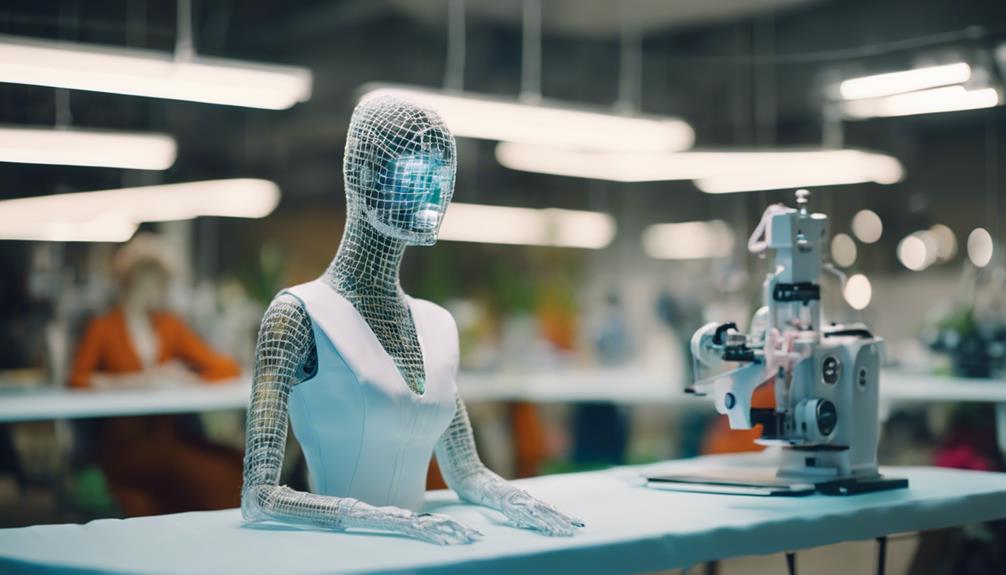
You might think that sustainable materials and new business models are the silver bullets for fashion's environmental issues, but that's not the whole story.
Many of these innovations face significant challenges that limit their effectiveness, often failing to align with consumer habits and industry practices.
It's essential to recognize that without a systemic shift, these solutions may only scratch the surface of what's needed for true sustainability.
Sustainable Materials Challenges
Sustainable materials promise innovation in fashion, yet many still fall short of making a meaningful impact on the industry's environmental footprint. Despite advances like biodegradable fabrics and plant-based alternatives, most clothing is still produced from non-biodegradable, petroleum-based materials. This reliance results in minimal change regarding the environmental impact of the fashion industry.
High-profile initiatives focusing on bio-based and recycled materials often don't greatly reduce carbon footprints, underscoring the limitations of current sustainable practices. When brands market sustainable materials without solid evidence of their benefits, it leads to consumer skepticism and the potential for greenwashing.
You might wonder about the effectiveness of second-hand, upcycled, and recycled materials in reducing overall waste. Unfortunately, these practices frequently fail to address the root causes of environmental degradation. While innovations like self-repairing garments and hyper-regional textiles show promise, their widespread adoption is still in its infancy.
Achieving genuine sustainability requires systemic change in both production methods and consumer behavior, meaning that, despite the buzz, we still have a long way to go before we can confidently claim strong sustainability credentials in fashion.
Effectiveness of New Models
New business models like recycling, resale, and rental promise to reshape the fashion landscape, but their actual effectiveness in reducing environmental harm remains questionable. While these approaches are often touted as integral to the sustainable fashion movement, their impact is limited by persistent consumer habits and industry practices that favor fast fashion cycles.
Even with high-profile innovations like recycled plastic and bio-based materials, substantial reductions in environmental impact are lacking. You might think that opting for second-hand or upcycled fashion makes a significant difference, but many brands continue to prioritize overproduction and non-biodegradable materials, undermining these efforts.
As consumers become more aware of the environmental consequences of their choices, it's critical to recognize that simply adopting new models isn't enough. The root causes of environmental degradation must be addressed, which often requires regulatory intervention rather than relying solely on voluntary market-based solutions.
Ultimately, for true sustainability in fashion, a shift in supply chains and accountability from companies is essential. Only then can we genuinely mitigate the industry's environmental impact and move toward a more sustainable future.
Regulatory Intervention Needs
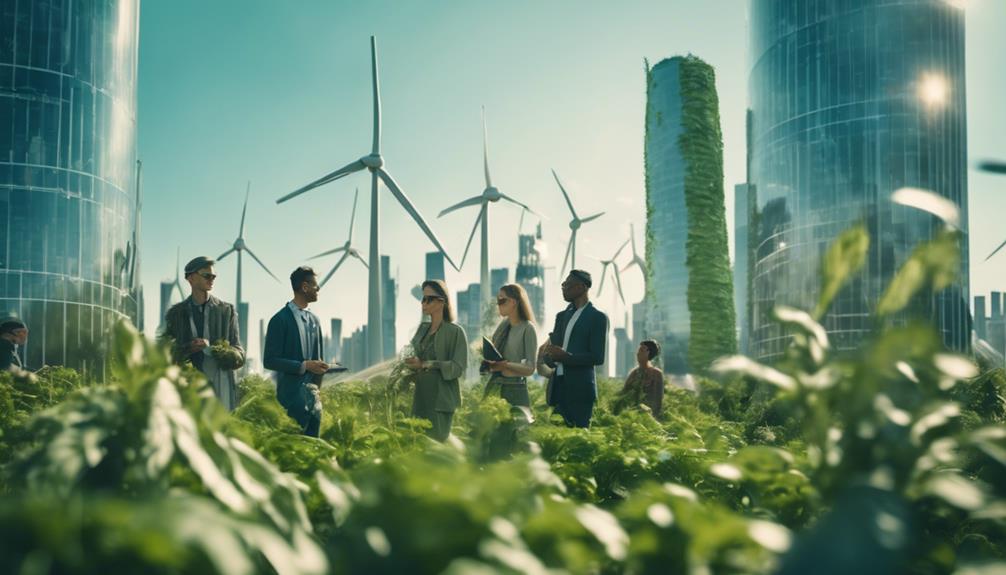
Regulatory intervention is essential to hold fashion companies accountable for their environmental impacts and guarantee they genuinely commit to sustainable practices. As it stands, current market-based solutions have failed to adequately address sustainability issues within the fashion industry. You may have noticed that many brands tout their eco-friendliness, but often, their actions don't match their claims. This gap in accountability calls for government action to enforce stricter regulations.
Regulatory frameworks can assure that companies not only adopt sustainable practices but also bear the costs of their negative environmental impacts. Existing voluntary strategies, like using bio-based materials or recycling, have proven insufficient in reducing the overall environmental footprint. By implementing regulations, you can expect measurable impacts that genuinely reflect companies' commitment to environmental responsibility.
The fashion industry's progressive public image often masks its actual practices, further emphasizing the need for regulations that demand genuine compliance with sustainability standards. With proper oversight, you'll see a shift towards true accountability and lasting change within the fashion industry, leading to a more sustainable future.
Emerging Business Models

As you explore the future of sustainable fashion, you'll notice innovative resale platforms transforming how you shop for clothes.
Upcycling and repair trends are gaining traction, encouraging you to rethink the way you value and maintain your wardrobe.
These emerging business models not only extend the lifecycle of garments but also help reduce waste in a rapidly changing industry.
Innovative Resale Platforms
Innovative resale platforms are transforming the fashion landscape by providing sustainable alternatives that resonate with eco-conscious consumers. With the second-hand market projected to reach $64 billion by 2024, it's clear that these platforms are becoming essential in promoting circular fashion. By allowing you to buy, sell, and trade pre-owned clothing, you're not only extending the lifecycle of garments but also helping to reduce waste and your environmental footprint.
Here's a look at some leading innovative resale platforms:
| Platform | Key Feature | Growth Rate |
|---|---|---|
| ThredUp | AI-driven recommendations | 21x faster than retail |
| Poshmark | Social shopping experience | Exponential growth |
| Depop | Youth-focused marketplace | Rapid user acquisition |
| Vestiaire Collective | Luxury second-hand items | Niche market leader |
| Grailed | Men's fashion specialization | Strong community focus |
These platforms not only promote sustainable clothing options but also foster trust through transparency and authenticity, making them an integral part of the future of fashion.
Upcycling and Repair Trends
Upcycling and repair trends are reshaping the fashion industry, encouraging you to embrace sustainable practices that extend the life of your garments.
More brands are now using upcycled materials to create innovative pieces, considerably reducing waste and carbon footprints. As you prioritize durability, the demand for repair services has surged, with businesses offering mending and alteration to keep your favorite clothes in circulation longer.
You'll notice many labels adopting circular business models, inviting you to return used items for refurbishment or recycling. This fosters a culture of reuse, helping you contribute to sustainability while minimizing landfill waste.
Platforms dedicated to second-hand fashion have also gained popularity, making it easier for you to find unique, high-quality pieces that reflect your values.
This cultural shift towards valuing timeless garments over fast fashion emphasizes investing in upcycled pieces that tell a story. By choosing to support these emerging trends, you're not just enhancing your wardrobe but also participating in a movement that prioritizes sustainability, encouraging a healthier planet for future generations.
Embrace these changes, and make a lasting impact with your fashion choices.
Predictions for Sustainable Materials
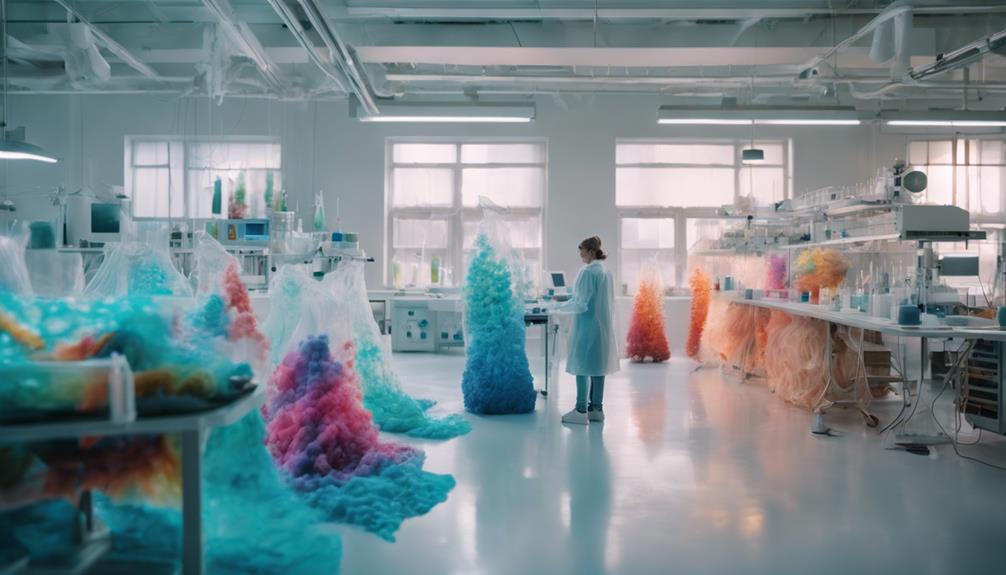
In the coming decades, you'll likely see a shift towards clothing made entirely from pre-existing materials, drastically cutting down on new resource extraction. This move will redefine sustainability in the fashion industry, focusing on innovation in material sourcing and production.
You'll witness the rise of sustainable synthetic materials, engineered to adapt to environmental conditions while offering enhanced functionality. Ethical harvesting of biodegradable materials, like fur from sustainable sources, will also become a priority.
Moreover, hyper-regional textiles made from low-water plants will emphasize local production, minimizing environmental impact. Innovations such as self-repairing garments, acting like enhanced secondary skin, will promote longevity and reduce waste.
Here's a quick overview of the sustainable materials you might encounter:
| Material Type | Key Feature |
|---|---|
| Pre-existing Materials | Reduces resource extraction |
| Biodegradable Fabrics | Eco-friendly, ethically sourced |
| Sustainable Synthetics | Adaptable and functional |
As these materials gain traction, you'll see the fashion industry embracing a more responsible approach, aligning creativity with sustainability. The future of fashion not only looks good but does good for the planet. This shift towards sustainable fashion trends is driven by consumer demand for transparency and ethical practices in the industry. By incorporating eco-friendly materials and ethical production methods, fashion brands can appeal to a growing market of environmentally conscious consumers. As the momentum for sustainable fashion continues to build, we can expect to see a positive impact on not only the planet, but also the people who work in the industry.
Consumer Attitudes and Shifts

A growing number of consumers are prioritizing quality and durability over fast fashion, reflecting a significant shift in attitudes towards sustainable clothing choices. This change is rooted in heightened awareness of environmental costs, prompting shoppers to embrace conscious consumerism.
You're likely noticing a surge in demand for transparency from brands, as consumers increasingly scrutinize sustainable practices and express skepticism towards greenwashing tactics.
Fashion trends are evolving, with more individuals advocating for fair labor practices and supporting local shopping and thrifting. This cultural shift emphasizes valuing citizenship over mere consumerism.
As you shop, you might find yourself drawn to traceable and circular sustainable materials, showcasing a growing interest in the origins and lifecycle of the garments you purchase.
Younger consumers are particularly engaged in this movement, extending their sustainability consciousness to areas like skincare, seeking natural products that align with their values.
This trend reflects an overarching desire for a more responsible and ethical approach to consumption. By aligning your choices with sustainability, you contribute to a powerful wave of change in the fashion industry, shaping a future that prioritizes both quality and ethical practices.
Technological Advancements in Fashion
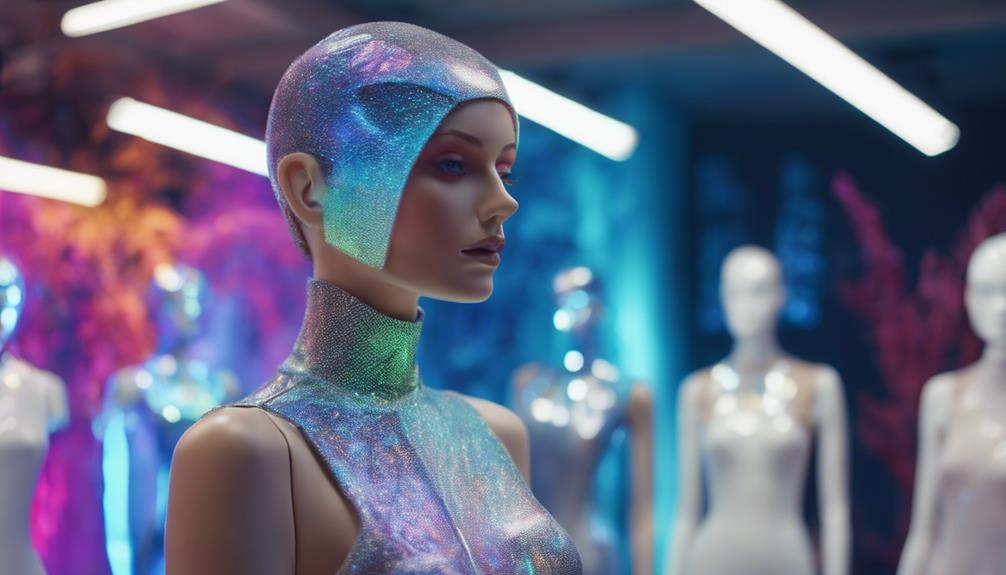
Embracing technological advancements is revolutionizing the fashion industry, making it more sustainable and efficient than ever before. One of the standout innovations is 3D body scanning, which tailors garments to individual body shapes, drastically reducing fabric waste.
As you explore the domain of smart materials, you'll discover fabrics that can track your activities, enhancing garment functionality and providing a better user experience.
Here are some key advancements shaping sustainable fashion:
- Digitalization: AI and blockchain optimize supply chains, ensuring transparency and efficiency.
- AI-driven design: This technology aids in creating more sustainable designs while minimizing resource consumption.
These technological advancements not only push the boundaries of traditional fashion but also pave the way for a more sustainable future.
As the industry evolves, you'll find that innovation is key to addressing environmental challenges and meeting the growing demand for sustainable fashion.
Embrace these changes, and you'll be part of a movement that values efficiency and sustainability.
Climate Resilience and Adaptation
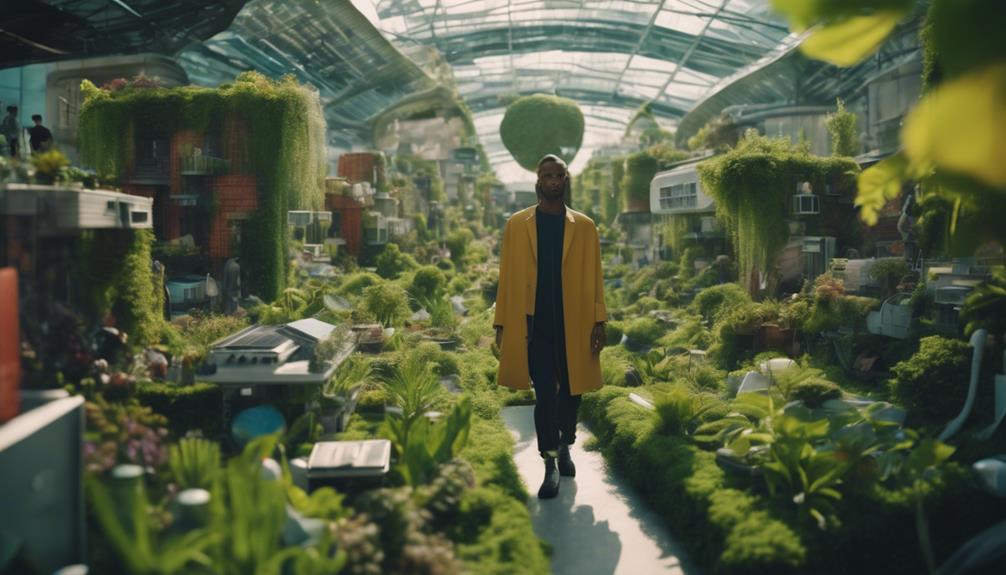
Future clothing designs will prioritize rapid adaptation to extreme weather conditions, ensuring you stay comfortable and protected in an unpredictable climate. As climate-related environmental hazards increase, you'll notice a growing demand for lightweight, sun-protective, and water-resistant fabrics. These innovations will focus on sustainability, meeting your needs while also being environmentally friendly.
Local textile production will gain importance as large-scale supply chains face challenges, emphasizing resilience and sustainability in fashion. You'll find that clothing won't only serve aesthetic purposes but also provide essential protection from pollution and climate-related conflicts.
The integration of climate resilience into fashion practices will mean you can expect garments designed to withstand severe weather events. This adaptation will help you navigate the impacts of climate change more effectively.
As a consumer, your choices will contribute to broader efforts against climate change, promoting a sustainable fashion future that prioritizes both style and practicality. By investing in these resilient designs, you'll support a movement towards a more sustainable and adaptable wardrobe that aligns with the challenges of our changing environment.
Frequently Asked Questions
What Is the Sustainable Future of Fashion?
The sustainable future of fashion means you'll embrace circular practices, prioritize quality over quantity, and favor innovative materials. You'll see personalized, smart garments that adapt to your needs while minimizing waste and environmental impact.
What Will Be the Future of Fashion?
By 2030, the digital fashion market's set to hit $50 billion, showing how virtual clothing's changing your shopping experience. You'll likely find innovative, sustainable practices and stylish, timeless pieces dominating the future fashion landscape.
What Is the Future of Sustainability in Fast Fashion?
The future of sustainability in fast fashion involves adopting circular models, prioritizing transparency, and embracing innovative technologies. As you become more discerning, brands will need to genuinely commit to sustainable practices to earn your trust.
What Is the Point of Sustainable Fashion?
Sure, you could keep buying fast fashion, but sustainable fashion's point is to save the planet. It encourages you to choose eco-friendly materials, support ethical brands, and reduce waste while looking fabulous. Who wouldn't want that?
Conclusion
As you can see, the future of sustainable fashion is a mixed bag of promise and challenges.
While innovative materials and business models are on the rise, consumer awareness and regulatory support are essential for real change.
You'll need to keep your ear to the ground and embrace new trends, because when it comes to sustainability, the ball's in your court.
By making informed choices, you can help steer the industry toward a greener path.









